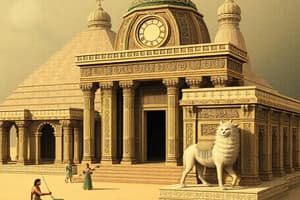Podcast
Questions and Answers
What was the primary consideration in selecting an arbiter from another barangay?
What was the primary consideration in selecting an arbiter from another barangay?
- Age and experience
- Family ties to the chiefs
- Reputation for fairness (correct)
- Proximity to the disputing parties
What was the consequence of having energetic and commanding chiefs?
What was the consequence of having energetic and commanding chiefs?
- They were highly respected and obeyed
- They were often deserted by their followers (correct)
- They were given more authority and power
- They were seen as a threat to the entire community
What was the primary goal of the judicial reform needed in the barangay system?
What was the primary goal of the judicial reform needed in the barangay system?
- To punish those who disobey the rules
- To ensure justice and strengthen the chiefs (correct)
- To increase the power of the chiefs
- To reduce the number of disputes and conflicts
What was the unique aspect of the Maharlica status in the barangay system?
What was the unique aspect of the Maharlica status in the barangay system?
What was the primary purpose of the strict regulations on marriage and movement in the barangay system?
What was the primary purpose of the strict regulations on marriage and movement in the barangay system?
What happens to the children of a maharlica and a slave if the father acknowledges them?
What happens to the children of a maharlica and a slave if the father acknowledges them?
What was the characteristic of the dispute resolution process in the barangay system?
What was the characteristic of the dispute resolution process in the barangay system?
Why did maharlicas have to pay a fine and host a banquet when moving between villages or barangays?
Why did maharlicas have to pay a fine and host a banquet when moving between villages or barangays?
What determines the classification of children as namamahay or sa guiguilir?
What determines the classification of children as namamahay or sa guiguilir?
What happens to the children of a free woman and a slave if the slave is the woman's husband?
What happens to the children of a free woman and a slave if the slave is the woman's husband?
What is a requirement for a dato's judgment in dispute resolution?
What is a requirement for a dato's judgment in dispute resolution?
Why did a maharlica father have to pay half a gold tael to the master of the slave woman?
Why did a maharlica father have to pay half a gold tael to the master of the slave woman?
What is true about the property of commoners (Aliping Namamahay)?
What is true about the property of commoners (Aliping Namamahay)?
What is true about the children of a maharlica and a slave if only one child is born?
What is true about the children of a maharlica and a slave if only one child is born?
Flashcards are hidden until you start studying
Study Notes
Social Structure
- Maharlicas (Nobles) retain their status indefinitely if they have noble parents on both sides.
- Children of maharlicas and slaves are half-free if acknowledged by the father; otherwise, they are entirely slaves.
- Children of free women and slaves are always free, unless the slave is the woman's husband.
Marriage and Children
- In marriages between a maharlica and a slave, children are divided: odd-numbered children belong to the father, and even-numbered children belong to the mother.
- If only one child is born, they are half-free and half-slave.
- Classification of children (namamahay or sa guiguilir) depends on the parent's status.
Social Classes
- Maharlicas: cannot move between villages or barangays without paying a fine in gold and hosting a banquet.
- Commoners (Aliping Namamahay): own their houses and property, inherited by their children, and cannot be sold or moved to another village.
- Slaves (Aliping Sa Guiguilir): can be sold, often granted portions of their harvest as incentives, and include war captives and debtors who can ransom their freedom.
Laws and Governance
- Movement between villages requires fines and banquets to avoid conflicts.
- Marriage can result in children being divided between barangays.
- Dispute resolution involves the presence of barangay members, with the option to appoint an arbiter from another barangay based on reputation for fairness.
Current Issues and Need for Reform
- People often prefer weak chiefs who do not enforce rules.
- Energetic and commanding chiefs are often deserted.
- Reform is needed to strengthen chiefs and ensure justice, with chiefs' decisions respected and executed within the barangay.
Studying That Suits You
Use AI to generate personalized quizzes and flashcards to suit your learning preferences.




